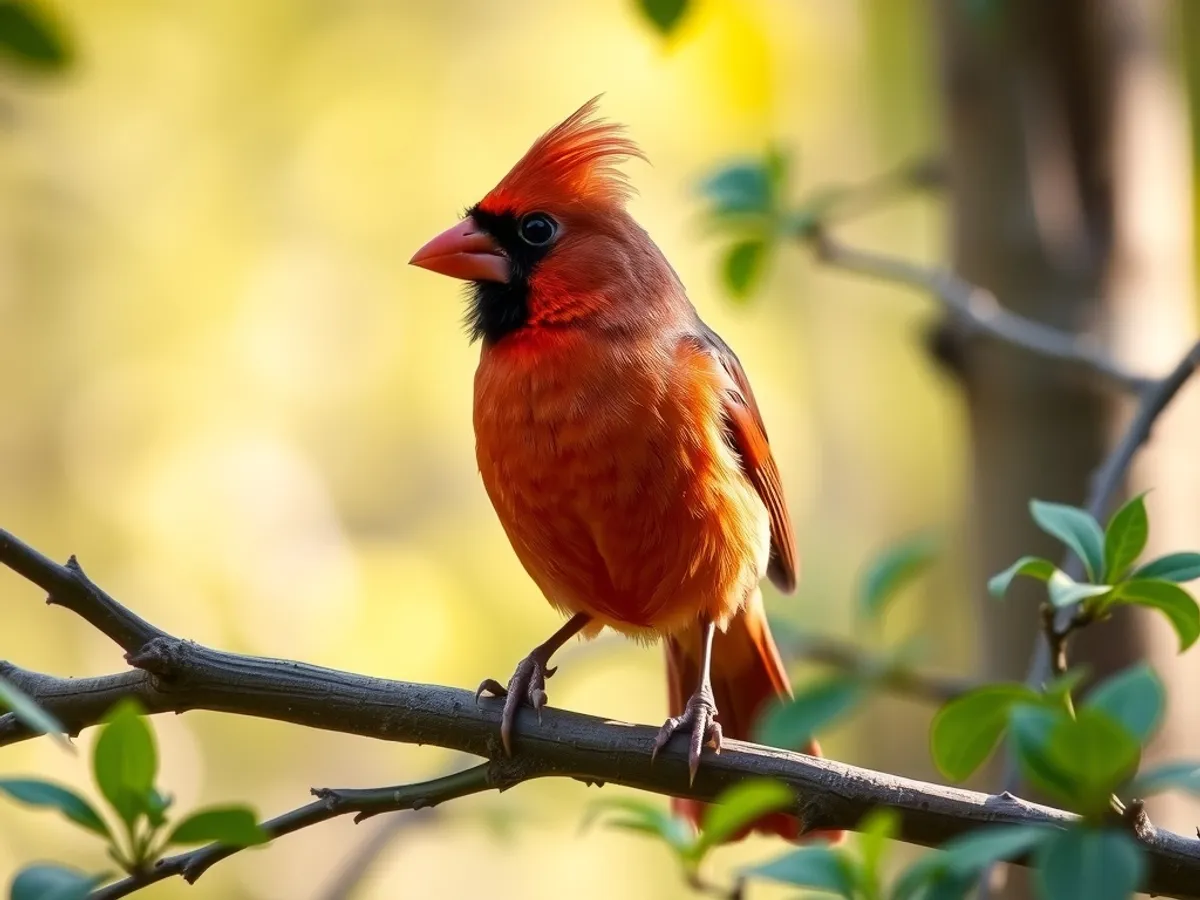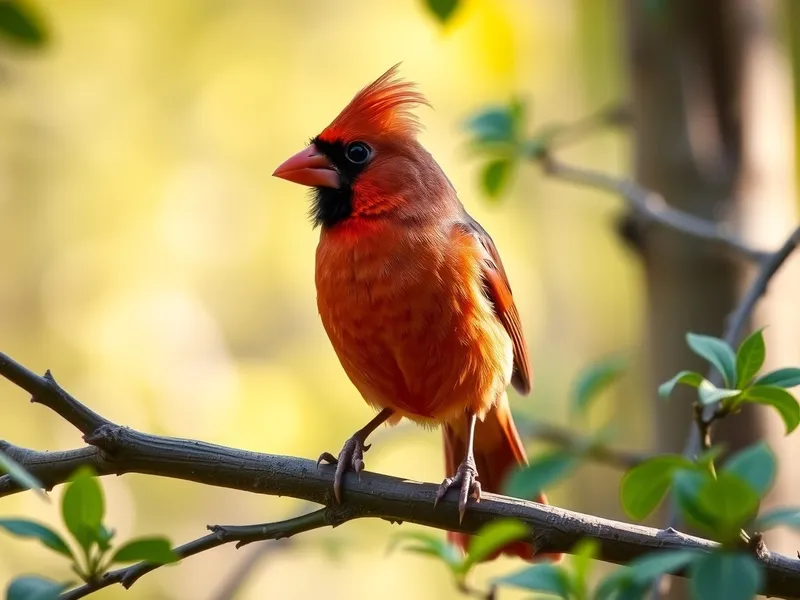
Northern Cardinal
Cardinalis cardinalis

Meet the Northern Cardinal
The Northern Cardinal is a striking songbird renowned for its vibrant red plumage in males and soft brownish tones with red accents in females. This medium-sized bird is easily recognized by its distinctive crest and strong, conical beak adapted for cracking seeds. Native to North and Central America, Northern Cardinals are non-migratory and thrive in a variety of habitats, including woodlands, gardens, and suburban areas. Their melodious songs and territorial calls are a familiar sound throughout their range, especially during the breeding season.
Classification
Bird
Habitat
Woodlands, gardens, shrublands, and suburban areas
Diet
Omnivore
Lifespan
3-5 years in the wild
Conservation
Least Concern
Weight
33-65 grams
📖Fascinating Facts
Both Sexes Sing
Unlike many songbirds, both male and female Northern Cardinals sing, often using their songs to communicate during nesting.
Seed Specialists
Their strong, thick beaks allow them to crack open tough seeds, which make up a significant part of their diet.
Bright Red Plumage
Male Northern Cardinals are known for their brilliant red feathers, which play a role in attracting mates and establishing territory.
📋Detailed Description
The Northern Cardinal (Cardinalis cardinalis) is a medium-sized passerine bird, measuring 21–23 cm (8.3–9.1 in) in length with a wingspan of 25–31 cm (9.8–12.2 in) and weighing 33–65 g (1.2–2.3 oz). Males are renowned for their brilliant crimson plumage, which is most intense on the crest, face, and underparts, while females display a more subdued buff-brown coloration with warm reddish tinges on the wings, tail, and crest. Both sexes possess a distinctive black facial mask that extends from the beak to the throat, more pronounced in males. The robust, conical bill is coral red and highly adapted for cracking seeds. Cardinals exhibit strong sexual dimorphism, not only in coloration but also in song complexity, with both sexes capable of singing—a rarity among North American songbirds. Their vocalizations are varied and include clear whistles, trills, and chips, which serve both territorial and mate-attraction functions. Northern Cardinals are non-migratory and highly territorial, often remaining in the same area year-round. They are primarily ground foragers, feeding on seeds, fruits, and insects, and are known for their acrobatic feeding behavior. Socially, they are monogamous and may form long-term pair bonds, with pairs often seen foraging together. Their adaptability to human-altered landscapes, such as suburban gardens and parks, has contributed to their widespread distribution and population stability.
💡 Did you know?
The Northern Cardinal is the state bird of seven U.S. states, more than any other bird species.
🔬Research & Sources
Wikipedia Summary
The northern cardinal, also commonly known as the common cardinal, red cardinal, or simply cardinal, is a bird in the genus Cardinalis. It can be found in southeastern Canada, through the eastern United States from Maine to Minnesota to Texas, New Mexico, southern Arizona, southern California and south through Mexico, Belize, and Guatemala. It is also an introduced species in a few locations such as Bermuda and all major islands of Hawaii since its introduction in 1929. Its habitat includes woodlands, gardens, shrublands, and wetlands. It is the state bird of Illinois, Indiana, Kentucky, North Carolina, Ohio, Virginia, and West Virginia.
Last Modified: 5/25/2025
🎭Behavior & Social Structure
Northern Cardinals are diurnal, most active during early morning and late afternoon. They are primarily seed-eaters but supplement their diet with insects, especially during the breeding season when protein is essential for chick development. Foraging typically occurs on or near the ground, where they use their strong beaks to crack open seeds and husks. Cardinals are known for their territorial aggression; males, in particular, will vigorously defend their territory against intruders, sometimes attacking their own reflection in windows or mirrors. Social interactions outside the breeding season can include small flocks, especially in winter, but pairs are the primary social unit. Both sexes sing, with females often singing from the nest, possibly to communicate with their mates. Cardinals engage in courtship feeding, where the male offers food to the female, reinforcing pair bonds. Bathing and preening are frequent behaviors, helping maintain feather condition and parasite control.
👶Reproduction & Life Cycle
Breeding typically begins in early spring and may continue through late summer, with pairs producing 2–4 broods per season in warmer regions. Courtship involves song duets, displays, and the aforementioned courtship feeding. The female constructs a cup-shaped nest using twigs, bark strips, grasses, and leaves, usually placed 1–3 m (3–10 ft) above ground in dense shrubs or low trees. Clutch size ranges from 2–5 eggs, which are pale greenish, bluish, or grayish with brown speckling. Incubation is performed solely by the female and lasts 11–13 days. Both parents participate in feeding the altricial chicks, which fledge after 9–11 days. Males often continue to care for fledglings while females initiate subsequent broods. High nest predation rates are common, but multiple broods increase reproductive success.
🛡️Adaptations & Survival
Northern Cardinals have evolved several adaptations for survival in diverse habitats. Their thick, conical bills are specialized for cracking hard seeds, a dietary staple, while their strong jaw muscles enhance feeding efficiency. The vivid red plumage of males is a sexually selected trait, signaling fitness to potential mates; carotenoid pigments responsible for the coloration are obtained from their diet. Their year-round residency is facilitated by their ability to exploit a wide range of food sources, including many provided by humans (e.g., bird feeders). Behavioral adaptations include aggressive territorial defense and complex vocalizations for communication. Their cryptic nesting behavior and preference for dense vegetation help reduce predation risk.
📚Research Sources
🎨Cultural Significance
The Northern Cardinal is deeply embedded in North American culture and symbolism. It is the state bird of seven U.S. states, more than any other species. Cardinals are often associated with vitality, hope, and the presence of loved ones in folklore and popular culture. Their striking appearance and melodious song have made them a favorite subject in art, literature, and music. In some Native American traditions, cardinals are seen as spiritual messengers or symbols of good fortune. The bird is also a popular mascot for sports teams and educational institutions.
🔬Recent Research & Discoveries
Recent research has focused on the genetic basis of plumage coloration, revealing that dietary carotenoids and specific genes (such as CYP2J19) are involved in red pigment production. Studies on vocalization have shown that both sexes sing, with female song playing a role in mate communication and territory defense. Ongoing research investigates the effects of urbanization on cardinal behavior, reproductive success, and adaptation to anthropogenic environments. Long-term banding and citizen science projects, such as those conducted by the Cornell Lab of Ornithology, continue to provide valuable data on population dynamics, migration patterns (where present), and responses to environmental change.
🎥Wildlife Videos

The Surprising Life of a Cardinal | Nature Documentary
We originally uploaded this video to our other channel "Lucinox" in 2022. We have since closed Lucinox, and are therefore ...
Fire of Learning

The NORTHERN CARDINAL | 10 FACTS about them
Northern Cardinals are one of the most loved birds around the world. Here are 10 interesting facts that you probably didn't know ...
Lesley the Bird Nerd

Birds Of US | Most Beautiful Birds In The United States | Wildlife Documentary | BBTV Official
Welcome to BBTV Official, In this celebration of avian splendor, we delve into the lives of the most beautiful birds across the United ...
BBTV Official

Northern Cardinal | One of the MOST ADMIRED Birds
One of the most admired backyard birds of North America, the Northern Cardinal is thought to be more responsible than any other ...
Lesley the Bird Nerd

The Amazing Northern Cardinal
Discover the captivating story of the Northern Cardinal, one of North America's most beautiful and iconic songbirds. With its vibrant ...
Birdie Learning

Northern Cardinal - HD Mini-Documentary
Mini-documentary about the Northern Cardinal. It's song look and habitat. Transcription: "With a crested head, black mask around ...
James Knott
🌍Habitat Information
The Northern Cardinal typically inhabits Woodlands, gardens, shrublands, and suburban areas environments. Northern Cardinals have adapted to their environments with specialized features and behaviors.
Primary Habitat:
Woodlands, gardens, shrublands, and suburban areas
More detailed habitat information will be available soon.
🛡️Conservation Status
The Northern Cardinal is currently classified as Least Concern. Conservation efforts are crucial for preserving this species for future generations.
Common Threats:
- 🏠Habitat loss and fragmentation
- 🌡️Climate change impacts
- 🎯Hunting and poaching
- 🏭Human-wildlife conflict
⚠️Threats & Conservation Challenges
Currently classified as Least Concern by the IUCN, Northern Cardinals face few significant threats due to their adaptability and broad range. However, local populations may be affected by habitat loss, window collisions, predation by domestic cats, and nest parasitism by Brown-headed Cowbirds (Molothrus ater). Climate change may influence range expansion, particularly northward, but could also impact food availability and nesting success in some regions. Overall, their population trend is stable or increasing, aided by the proliferation of backyard bird feeders and ornamental plantings.
🔬Scientific Classification
Scientific Name
Cardinalis cardinalis
Classification Hierarchy
🔍 About Taxonomic Classification
Taxonomic classification is a hierarchical system used by scientists to classify and organize living organisms based on shared characteristics and evolutionary relationships.
The system moves from broad categories (Kingdom) to increasingly specific ones, with each animal's scientific name typically consisting of its Genus and species.
📝Community Notes
Share your observations and insights about the Northern Cardinal with our community of wildlife enthusiasts.
Join Our Community
Sign in to share your observations and connect with fellow wildlife enthusiasts.
Sign In to ContributeNo community notes yet
Be the first to share your observations about the Northern Cardinal!
Explore Northern Cardinal
Select a tab above to learn more about this amazing animal.
📸Photo Gallery
No photos available for this animal yet.
🌟Discover More Wildlife
Continue your journey of discovery with more fascinating animals from our database
